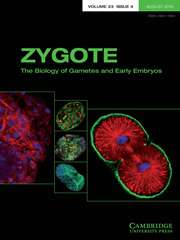Article contents
Improved exogenous DNA uptake in bovine spermatozoa and gene expression in embryos using membrane destabilizing agents in ICSI-SMGT
Published online by Cambridge University Press: 15 January 2018
Summary
Sperm-mediated gene transfer (SMGT) is a simple, fast, and economical biotechnological tool for producing transgenic animals. However, transgene expression with this technique in bovine embryos is still inefficient due to low uptake and binding of exogenous DNA in spermatozoa. The present study evaluated the effects of sperm membrane destabilization on the binding capacity, location and quantity of bound exogenous DNA in cryopreserved bovine spermatozoa using Triton X-100 (TX-100), lysolecithin (LL) and sodium hydroxide (NaOH). Effects of these treatments were also evaluated by intracytoplasmic sperm injection (ICSI)-SMGT. Results showed that all treatments bound exogenous DNA to spermatozoa including the control. Spermatozoa treated with different membrane destabilizing agents bound the exogenous DNA throughout the head and tail of spermatozoa, compared with the control, in which binding occurred mainly in the post-acrosomal region and tail. The amount of exogenous DNA bound to spermatozoa was much higher for the different sperm treatments than the control (P < 0.05), most likely due to the damage induced by these treatments to the plasma and acrosomal membranes. Exogenous gene expression in embryos was also improved by these treatments. These results demonstrated that sperm membrane destabilization could be a novel strategy in bovine SMGT protocols for the generation of transgenic embryos by ICSI.
Information
- Type
- Short Communication
- Information
- Copyright
- Copyright © Cambridge University Press 2018
References
- 2
- Cited by

